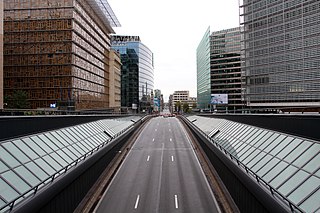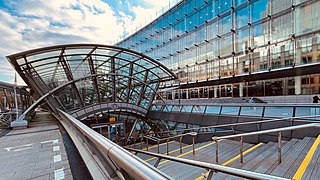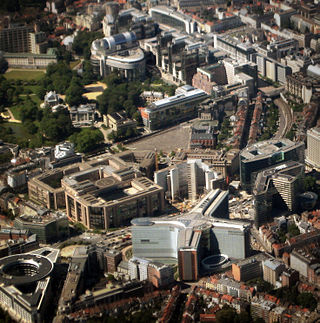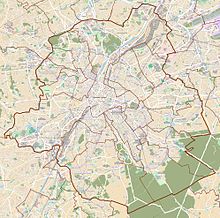
The City of Brussels is the largest municipality and historical centre of the Brussels-Capital Region, as well as the capital of the Flemish Region and Belgium. The City of Brussels is also the administrative centre of the European Union, as it hosts a number of principal EU institutions in its European Quarter.

The Berlaymont is an office building in Brussels, Belgium, which houses the headquarters of the European Commission, the executive branch of the European Union (EU). The structure is located on the Robert Schuman Roundabout at 200, rue de la Loi/Wetstraat, in what is known as the "European Quarter". The unique form of the Berlaymont's architecture is used in the European Commission's official emblem. The building is named after the Convent of the Ladies of Berlaymont.

The Palace of Justice of Brussels or Law Courts of Brussels is a courthouse in Brussels, Belgium. It is the country's most important court building, seat of the judicial arrondissement of Brussels, as well as of several courts and tribunals, including the Court of Cassation, the Court of Assizes, the Court of Appeal of Brussels, the Tribunal of First Instance of Brussels, and the Bar Association of Brussels.

Brussels-Schuman railway station is a railway station in the City of Brussels, Belgium, serving the European Quarter. It received its name from the area around the Robert Schuman Roundabout, itself named after Robert Schuman, one of the founding fathers of the European Union.

Maelbeek or Maalbeek is a Brussels Metro station in the City of Brussels, Belgium. Its name originates from the Maalbeek stream.

The Rue de la Loi or Wetstraat (Dutch), meaning "Law Street", is a major street running through central and eastern Brussels, Belgium, which is famous due to the presence of several notable Belgian and European Union (EU) governmental buildings. The road runs from the Rue Royale/Koningsstraat, in central Brussels, to the Robert Schuman Roundabout in its European Quarter. It forms the first (westerly) part of the N3 road that runs to Aachen, Germany.

The Justus Lipsius building, located in the European Quarter of Brussels, Belgium, was the headquarters of the Council of the European Union from 1995, and the de facto home of the European Council from 2002, until their relocation to the adjacent newly constructed Europa building at the beginning of 2017.

Brussels (Belgium) is considered the de facto capital of the European Union, having a long history of hosting a number of principal EU institutions within its European Quarter. The EU has no official capital but Brussels hosts the official seats of the European Commission, Council of the European Union, and European Council, as well as a seat of the European Parliament. In 2013, this presence generated about €250 million and 121,000 jobs. The main rationale for Brussels being chosen as "capital the European Union" was its halfway location between France and Germany, the two countries whose rivalry played a role in starting the two World Wars and whose reconciliation paved the way for European integration.

The Avenue Louise or Louizalaan (Dutch) is a major thoroughfare in Brussels, Belgium. It is located in the southern part of the City of Brussels, on the border with the municipality of Ixelles, where it runs south–east from the Place Louise/Louizaplein to the Bois de la Cambre/Ter Kamerenbos, covering a distance of 2.7 km (1.7 mi). It is named in honour of King Leopold II's eldest daughter, Princess Louise (1858–1924).

Leopold Park is a public park of 6.43 ha located within the Leopold Quarter of Brussels, Belgium. It is adjacent to the Paul-Henri Spaak building, the seat of the European Parliament. It is served by the metro stations Maalbeek/Maelbeek and Schuman on lines 1 and 5 of the Brussels Metro.

The Europa building is the seat of the European Council and Council of the European Union, located on the Rue de la Loi/Wetstraat in the European Quarter of Brussels, Belgium. Its defining feature is the multi-storey "lantern-shaped" construct holding the main meeting rooms; a representation of which has been adopted by both the European Council and Council of the EU as their official emblems.

Brussels-Luxembourg railway station is a railway station in the European Quarter of Brussels, Belgium, under the Esplanade of the European Parliament.

The Leopold Quarter is a quarter of Brussels, Belgium. Today, the term is sometimes confused with the European Quarter, as the area has come to be dominated by the institutions of the European Union (EU) and organisations dealing with them, although the two terms are not in fact the same, with the Leopold Quarter being a smaller more specific district of the municipalities of the City of Brussels, Etterbeek, Ixelles and Saint-Josse-ten-Noode.

The Place du Luxembourg (French) or Luxemburgplein (Dutch), meaning "Luxembourg Square", is a square in the European Quarter of Brussels, Belgium. It is better known by local European bureaucrats and journalists by one of its nicknames, Place Lux or Plux.

The Lex building is a high-rise of government offices in the European Quarter of Brussels, Belgium. It is an annex building of the Council of the European Union and is located at 145, rue de la Loi/Wetstraat.

The Convent Van Maerlant is a former convent which consists of a church and the Chapel of the Resurrection on the Rue Van Maerlant/Van Maerlantstraat in Brussels, Belgium. It is named after Jacob van Maerlant, a famous medieval Flemish poet.

The Esplanade of the European Parliament, or simply the Mall, with its most representative part Solidarność 1980 Esplanade, is a pedestrian mall in Brussels, Belgium, completed in 2002.

The Jardin de la vallée du Maelbeek (French) or Maalbeekdaltuin (Dutch) is a small green space on the corner of the Rue de la Loi/Wetstraat and the Chaussée d'Etterbeek/Etterbeeksesteenweg at the heart of the European Quarter of Brussels, Belgium. It was inaugurated on 13 May 1951.

The tram route 51 in Brussels, Belgium, is a tram route operated by STIB/MIVB, which connects Heysel/Heizel metro station in the City of Brussels to the Van Haelen stop in the municipality of Uccle. The route runs north–south, crossing the City of Brussels, Jette, Molenbeek-Saint-Jean, the City of Brussels again, Saint-Gilles, Forest and Uccle. Currently, service is interrupted between Brussels-South railway station and Altitude Cent/Hoogte Honderd due to construction work at Albert premetro station.

The Church of St. Augustine is a Roman Catholic parish church located in Forest, a municipality of Brussels, Belgium. It is dedicated to Saint Augustine.
























